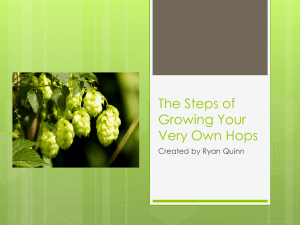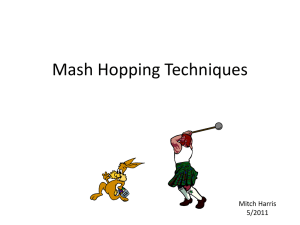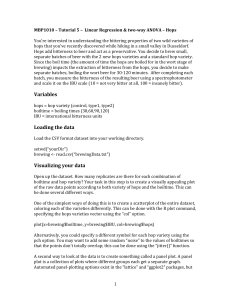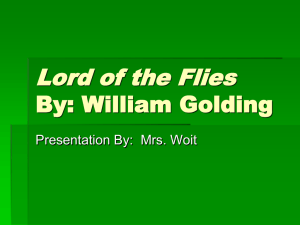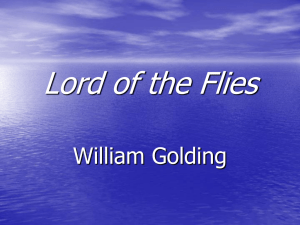Appendix three: What makes British Hops unique
advertisement
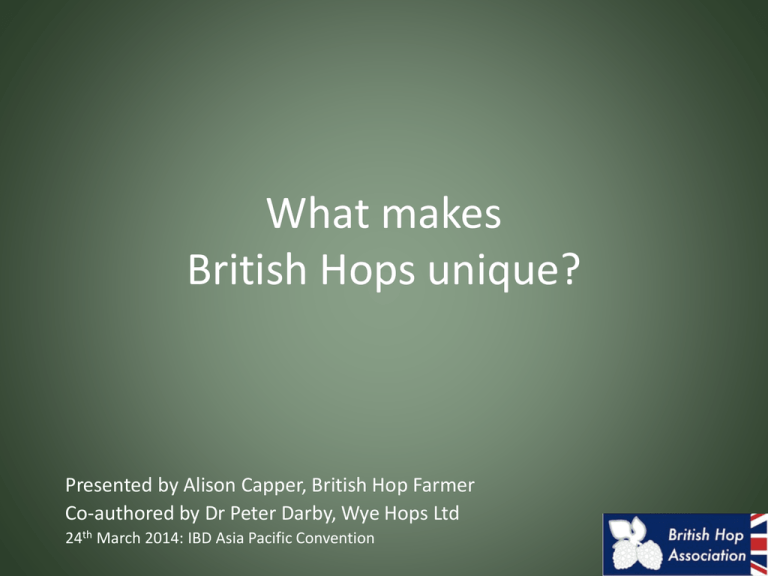
What makes British Hops unique? Presented by Alison Capper, British Hop Farmer Co-authored by Dr Peter Darby, Wye Hops Ltd 24th March 2014: IBD Asia Pacific Convention Key Components of Uniqueness • Latitude • Climate & Soil = “Terroir” • Irradiation (hours of sunshine) • Breeding History And then… • World Varieties – British Pedigree • Busting the myths - Seeded Hops • Aroma Hops What do we mean by British? Where do Hops grow in the UK? Where do hops grow in the world & why? On family farms, big and small, all over the world. World Hop Growing North West USA: Washington Oregon Idaho Europe: Germany Czech Republic Slovenia Australasia: Tasmania New Zealand For home market & export For home market only Latitude: 35-55° Daylight length, temperature, precipitation. Climate • “Climate is what you expect, weather is what you get” • Climate measures average patterns of variation (over at least 30 years): – Temperature – Precipitation – Humidity – Atmospheric pressure – Wind What affects Climate? • • • • • Latitude Altitude Terrain Nearby water bodies Currents Climate Semi-arid Continental Maritime Definition: Semi-arid climate (cold) • • • • • Intermediate of desert and humid climates Low rainfall Dominated by grasses or shrubs Features hot, dry summers & cold winters Higher elevation, temperature swings North-West USA: Washington State, Idaho Continental climates • Lacks significant water bodies nearby • Significant variation in temperature: – Cold winters with snow – Hot summers, moderate rainfall Germany, Czech Republic, Slovenia Maritime climate • Warm (not hot) summers • Cool (not cold) winters • Annual temperature range smaller than semiarid and continental climates • Even annual precipitation (no “dry” season) United Kingdom, Oregon (USA), New Zealand, Tasmania (Australia) BUT… British Hops are unique • The UK, Oregon State (USA), New Zealand and Tasmania, Australia do all have maritime climates • And all have long daylight length but all except the UK have higher light levels The UK has a “Dull maritime” climate Sunlight levels lower in UK “Terroir” The complete natural environment of a fruit that affects the characteristic taste and flavour, including factors such as: • soil • geography • geology • topography • climate Ideal Hop Growing Soil Types/Irrigation • Good quality, deep, well drained loamy or sandy soils • Sufficient warmth and moisture, otherwise irrigated • Majority of British Hops are NOT irrigated • All semi arid and most continental and other maritime hops are irrigated What does the unique British terroir deliver to the Brewer? • Lower myrcene content • Myrcene indicates monoterpene content • Monoterpenes = aroma intensity, e.g. – Geraniol: rose, geranium, lemon – Limonene: orange, lemon, citrus – Turpeniol: pine, turpentine, green, woody Terroir Analysis Myrcene Differentiation Variety Analysis Long-term ave UK NZ Fuggle myrcene 24.5 32.0 Challenger myrcene 29.3 43.5 Target myrcene 40.9 57.7 Cascade myrcene 42.3 USA 58.1 What does the unique British Hop terroir deliver to the Brewer? • Delicate, gentle, complex aromas • Aromas that produce complex, delicate, flavours in the beer • Drinkable, “session” beers Perfect Beer Styles for British Hops Pale Ale India Pale Ale Porters Stouts What else is unique about British Hops? A World Leading Hop Breeding Programme Professor ES Salmon Dr RA Neve Dr WG Keyworth, East Malling Research Dr Peter Darby British Hop Breeding History • 1669: • 1906: By growers for Yield & Aroma Prof E S Salmon at Wye College planted out new hop seedlings to create new Alpha / Bittering varieties that “possess marketable value” • 1949: Dr W G Keyworth, wilt resistance • 1953: Dr R A Neve, disease & wilt resitance British Hop Breeding History • 1981: Dr Peter Darby Pioneer of “dwarfed” varieties: First Gold, Sovereign (to reduce production costs and environmental impact) World’s first aphid-resistant variety: “Boadicea” Aroma breeding British Hop Breeding • • • • • • Long established… Foundation of world hop breeding in 20th century Source of all the world’s bitter hop varieties Best in world for scientific innovation World leader on hop disease resistance Pioneers in environmental sustainability & lowering production costs Who bred which Varieties? Growers: 1737: Mathon (aka Canterbury Whitebine) 1790: Old Golding (from Canterbury Whitebine) 1805: Colegate 1838: East Kent Golding (aka Canterbury Golding) 1865: Bramling 1875: Fuggle 1881: Cobbs 1887: Early Bird (Amos) 1889: Eastwell Golding 1932: WGV (Whitbread Golding Variety) Who bred which Varieties? Prof E S Salmon: 1934: Brewers Gold 1938: Bullion 1940: Nonsuch 1944: Northern Brewer 1946: Pride of Kent 1948: Early Choice 1949: Keyworths Early / Midseason 1951: Bramling Cross Who bred which Varieties? Dr W G Keyworth: 1960: Defender 1960: Density 1960: Janus Who bred which Varieties? Dr R A Neve: 1967: Progress 1971: Northdown 1972: Challenger 1972: Target 1983: Yeoman Who bred which Varieties? Dr Peter Darby: 1996: Admiral 1996: First Gold 1996: Phoenix 1996: Pioneer 2001: Pilgrim 2001: Pilot 2004: Boadicea 2006: Sovereign tbc: Endeavour What is the British Hop Aroma Pedigree? Quintessentially British Golding (1790): Spicy, honey, earthy BRITISH Fuggle (1875): Minty, Floral, Earthy WORLD Perfect alone or in combination Goldings Modern Family Tree 1919 - 1961 Bullion Brewers Gold Bramling Golding Pride of Kent Early Choice Nonsuch OB53 Keyworths Midseason Bramling Cross 1147 / WGV Northern Brewer Goldings Modern Family Tree 1961 - 1985 Wye Northdown Progress Keyworths Early Omega Wye Challenger Wye Target Admiral Yeoman Phoenix Pilgrim First Gold Goldings Modern Family Tree 1986 to date Herald Pioneer Pilot Boadicea Sovereign Endeavour World Varieties : “The Fuggle Heritage” 0 Generation = British Fuggle Savinski Golding US Tettnang Styrian Golding Early Green Slovenia USA 1st Generation from British Fuggle Celeia Smoothcone Cerera Slovenia Columbia Willamette New Zealand USA 2nd Generation from British Fuggle Buket Green Bullet Cascade Superalpha Cicero Pacific Gem Nugget Southern Cross Cekin Nelson Sauvin Slovenia New Zealand USA 3rd Generation from British Fuggle Citra Horizon USA 4th Generation from British Fuggle Centennial Crystal Mt Rainier Sterling USA 5th Generation from British Fuggle Chelan Millenium Newport Santiam Glacier USA Why are British Hops Seeded? And is it a problem? Seeded Hops • All hops are seeded if male hops are present • Male hops are present naturally in the British landscape • A landscape of historic hedgerows that naturally divide fields • A landscape that we want to protect British Landscape Hedgerows up close Are seeded hops a problem? • Untrue that seeded hops affect beer quality • Trials in Switzerland in 1978 on standard Continental lager disproved this theory “Hop products from seeded hops had no adverse effect on beer quality and the flavour of all beers was acceptable with no statistical significance for differentiation or preference” Do seeded hops “cost” more? • No, another myth • The resin in the hop flower remains constant regardless of the presence of seeds • So when buying alpha acid %, the seeded hop has the same value as the unseeded hop Seeded Hop Calculation Say a cone is 75 parts leaf, 10 parts resin and 1 or 10 parts seed Seeded Hop Calculation Seed = 10 ÷ 95 x 100 Resin = 10 ÷ 95 x 100 = 10.5% = 10.5% Seedless Hop Calculation Seed = 1 ÷ 86 x 100 Resin = 10 ÷ 86 x 100 = 1.2% = 11.6% Yield Yield x Resin Seeded 95 x 10.5% Seedless 86 x 11.6% = 9.98 = 9.98 = Constant British Aroma Hops British Aroma Hops • Complex, mostly delicate with some high notes • Aroma notes that include: citrus, orange, mint, pepper, blackcurrant, lemon, chocolate, sage, pine, apricot, floral, honey Today’s British Hop Varieties British Hop Aroma Varieties Variety Alpha Range Characteristics Admiral 13 - 16 Resinous, orangey, citrus Flavour Intensity 9 Cascade (UK) 5-9 Lychees, floral, grapefruit 9 Target 8.5 - 13.5 Sage, citrus, spice 9 Bramling Cross 6-8 8 Pioneer 8 - 10.5 Spicy, blackcurrant, lemon Cedar, grapefruit, herbal Challenger 6.5 - 9 Spicy, cedar, green tea 7 Endeavour 8 - 10.5 Blackcurrant, spicy, citrus 7 Northdown 7 - 10 Spicy, floral, pine 7 WGV 5 - 7.5 Spicy, botanical, floral 7 Beata 3-6 Honey, apricot, almond 6 8 British Hop Aroma Varieties (contd) Variety Alpha Range Characteristics Flavour Intensity Boadicea 7 - 10 Spicy, light floral 6 East Kent Goldings 4-6 Spicy, honey, thyme 6 First Gold 6.5 - 10 Orange, marmalade, spicy 6 Fuggle 3.5 - 6.5 Minty, floral, earthy 6 Goldings 4 - 9.5 Spicy, honey, earthy 6 Pilgrim 9 - 13 Spicy, citrus, pears 6 Progress 6 - 7.5 Sweet, floral, minty 6 Sovereign 4.5 - 6.5 Herbal, floral, earthy 6 Phoenix 8 -12 Molasses, chocolate, spicy 5 Pilot 8 - 11 Lemon, spicy, marmalade 5 www.britishhops.org.uk Alison Capper: alicapper@mac.com Twitter: @BritishHops
